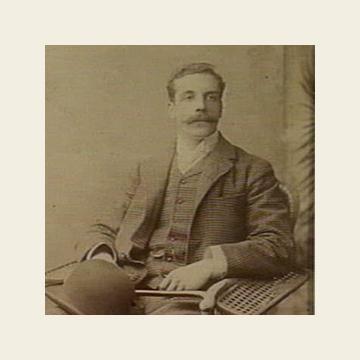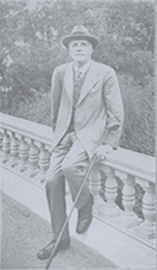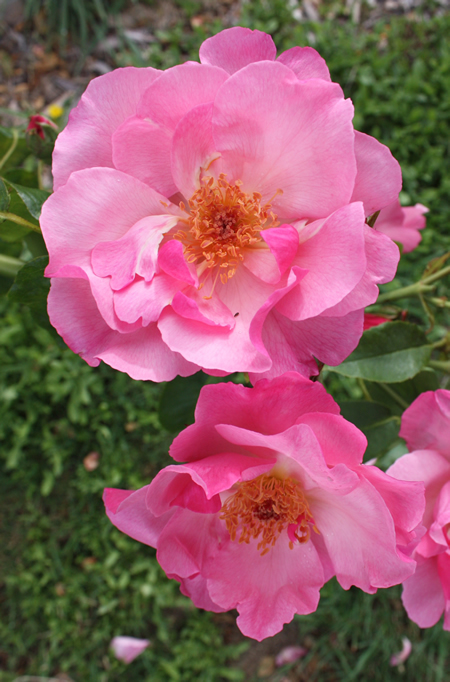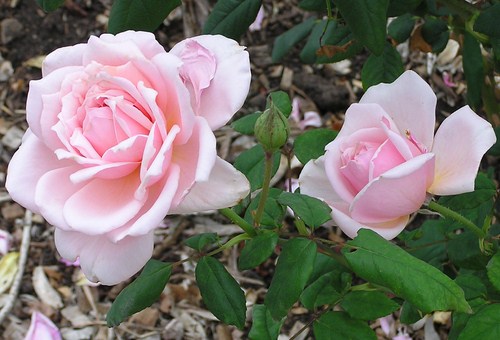The Australian "Man of Roses"
Alister Clark (1864-1949)
There are many successful rose breeders in Australia but none are as well known as Alister Clark. While many rose breeders search for the perfect colour, form or perfume, Alister was much more interested in making the most of our temperate climate. He wanted to breed roses that would flower throughout the year.The most significant rose used in his breeding program was the great creamy- coloured single rose, ‘R. gigantea’ . which originates in the Himalayas and in Burma. Here it climbs to heights of twelve metres through trees. Because of its susceptibility to cold it has not been widely used by European breeders, although there were presentations at the recent International Rose Conference on the success of roses bred from ‘R. gigantea’ in Mediterranean countries. He also concentrated on roses for the garden rather than roses to show. And indeed he did succeed with ‘Lorraine Lee’ and ‘Nancy Hayward’ in particular. These roses will bloom all year round, and ‘Squatters Dream’ is rarely without a flower.


Unfortunately after Alister’s death in 1949 many of his roses were lost. He had released well over one hundred and twenty. In the late nineteen eighties in Victoria, Susan Irvine and John Nieuwesteeg became interested in finding and preserving as many of these roses as possible. Between them they have found many of the roses – chiefly from the families of the women after whom the roses were named. The collection of Alister Clark roses was one of the first collections established and registered with the newly formed Ornamental Plant Collections (OPCA). In her book ‘ A Hillside of Roses, Hyland House’ 1994, (the source of information for this article), Susan Irvine lists 47 roses identified “with as much certainty as possible”. The second list of seven roses are thought to be Alister Clark but cannot be confirmed. Detailed descriptions and photographs of the roses appear in the Appendix of her book. Many of the roses are available commercially and are now widely grown.
Many of the Alister Clark roses do require space in a large garden but some are very suitable for our smaller garden. With this in mind Susan is establishing a bed of smaller Alister Clark roses for our Conference delegates to view in her garden on the Post Conference tour to Tasmania in 2008. The following article describes her plans. Susan is widely recognised in Australia as an eminent rosarian. She has established wonderful gardens at Bleak House and Erinvale (in Victoria) and now in Tasmania at Forest Hall. Her books and articles are widely read and HRIAI acknowledge with great respect her work in tracing, identifying, and preserving lost and forgotten roses in Eastern Australia. Susan was the recipient of the Deane Ross Memorial Award at the 2006 Conference.
Alister Clark roses at Forest Hall
Susan Irvine, Elizabeth Town, TAS. June 2007
Nine inches of rain in May! During the long dry spell which we shared with most of Australia I had put aside any thought of planting this winter, but now with the paddocks turning emerald green again, the dams full and the lake that supplies the garden overflowing I have taken out my rose catalogues and turned again to planning a garden I had started to think about months before.
Many of the Alister Clark roses at Forest Hall are hybrids of the rampant R. gigantea from Burma, towering up into trees, hard to discipline and occupying a great deal of space. Many of the visitors to the garden, although they found 'Mrs.Richard Turnbull' on the drive quite breathtakingly beautiful and 'Golden Vision' and pale pink 'Jessie Clark' climbing up the peach trees enchanting, felt compelled to abandon any thought of planting them in their suburban gardens. 'Courier' and 'Tonner's Fancy', 'Cicely Lascelles' (pictured) and 'Cicely O'Rorke', 'Flying Colours' and 'Harbinger' growing on the back drive had to be omitted for the same reason.

So my plan for this winter's planting concentrates on the smaller roses bred by this great rosarian, for there are some which can be accommodated even in the most modest of gardens Top of my list are two of the smallest of all – ‘Borderer’ and 'Suitor'. I first saw 'Borderer' in the garden at Delatite in Victoria. Very low growing and constantly in flower, this little pink rose was used as a border throughout the formal rose garden. It was one of Alister's earliest, released in 1918, and is now finding favour again. I have ordered six plants. 'Suitor' is just as low growing with bright pink flowers fading to white, very recurrent and strongly perfumed. It grows and flowers profusely in Tid Alston's garden. It is possible that it was never formally released although it is listed in Modern Roses, the world encyclopedia of roses, under Alister's name with the date 1942. It deserves to be much more widely planted, and as I like things growing in groups rather than singly I ordered three.
Like 'Borderer', 'Marjory Palmer' is a rich pink polyantha bred from the vigorous American rambler 'Jersey Beauty'. In the same way as 'Borderer' and 'Suitor' it could be used very effectively as a hedge or as a border to a bed. Like them it is remarkably recurrent. So three of these are on my list. 'Diana Allen' produces salmon-pink flowers on a bushy compact plant. Its frilly petals led to its being nicknamed 'the carnation rose'. Three more for my list. It was released in 1939 and the plant grown in Victoria was identified by David Ruston.

The Hybrid Tea 'Fairlie Rede' (pictured), bred from the New Zealand rose 'Mrs.E.Willis' produces pale pink classic shaped flowers recurrently. Another three for the list. 'Sunlit' is also a Hybrid Tea. Its rich apricot pink flowers are produced over an exceptionally long period, in fact, well into winter. Certainly worth three on the list. Last but by no means least I added three 'Sunny South' which was probably Alister's favourite of all the roses he bred. Taller than the others listed here it produces pale pink semi-single flowers recurrently and makes a grand hedge. I will put my three at the back of the bed.
By chance I found a young stonemason and bought from him a pretty sundial to act as centrepiece for this garden of low-growing Alister Clark roses. Twenty-four in all, hardy and drought resistant and exceptionally recurrent, they will provide colour in the daffodil paddock when most of the roses there are over. After my plan was completed I added three plants of the glowing golden 'Lady Huntingfield' to the list. Bred from Alister's 'Busybody' and an unknown seedling, it is vigorous and bushy and very recurrent, but its colour makes it unsuited to planting among the others. So I have ordered five and will give them a spot all to themselves, perhaps near the creamy-yellow Rugosa rose 'Agnes'.
© Susan Irvine
